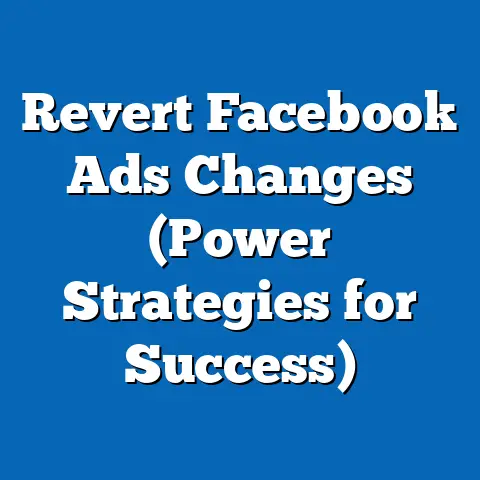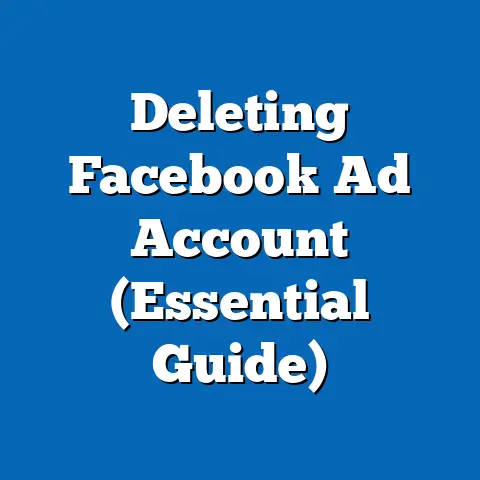Unlock 360-Degree Ads on Facebook (Enhanced Engagement Tactics)
Unlocking 360-Degree Ads on Facebook: Enhanced Engagement Tactics and the Intersection with Eco-Friendly Advocacy
The digital advertising landscape has undergone a transformative shift with the advent of immersive formats like 360-degree ads on platforms such as Facebook. These ads, which allow users to interact with panoramic visuals and videos by tilting their devices or dragging their cursor, have redefined user engagement by offering a more dynamic and participatory experience. As businesses and advocacy groups increasingly adopt these tools, it is critical to examine how specific demographic segments—such as eco-friendly advocates—interact with and respond to such innovative advertising strategies.
Part I: Understanding Eco-Friendly Advocates
Demographic Composition
Eco-friendly advocates, often referred to as “green” or environmentally conscious individuals, represent a diverse yet identifiable demographic within the broader political and social spectrum. According to a 2022 Pew Research Center survey, approximately 59% of Americans express concern about climate change, with a subset of about 31% identifying as highly engaged in environmental advocacy—often aligning with eco-friendly behaviors such as reducing waste, supporting renewable energy, and purchasing sustainable products. This group skews younger, with 45% of adults under 30 identifying as environmentally conscious compared to only 25% of those over 65 (Pew Research Center, 2022).
Geographically, eco-friendly advocates are more concentrated in urban and coastal areas, with states like California, Oregon, and Washington showing higher densities of green-leaning individuals (Yale Program on Climate Change Communication, 2021). Racially and ethnically, this group is somewhat diverse but leans toward higher representation of White Americans (62%) compared to Black (12%) and Hispanic (18%) individuals, reflecting broader access to environmental education and resources in certain communities (Gallup, 2021). Education also plays a significant role, as 68% of eco-friendly advocates hold a college degree or higher, compared to 39% of the general population (Pew Research Center, 2022).
Core Beliefs and Values
At the heart of eco-friendly advocacy lies a commitment to sustainability, climate action, and the protection of natural resources. Surveys indicate that 78% of this group believes climate change is a major threat to global stability, and 82% support policies aimed at reducing carbon emissions (Yale Program on Climate Change Communication, 2021). They often prioritize systemic change over individual actions, advocating for government and corporate accountability in environmental stewardship.
This group also values interconnectedness, viewing environmental issues as tied to social justice, economic equity, and global health. For instance, 65% of eco-friendly advocates support the concept of a “just transition” to renewable energy, ensuring that workers in fossil fuel industries are retrained for green jobs (Gallup, 2021). Their worldview often emphasizes long-term thinking, with a focus on preserving the planet for future generations.
Voting Patterns and Political Engagement
Eco-friendly advocates tend to align with progressive political ideologies, with 72% identifying as Democrats or leaning Democratic, compared to just 18% aligning with Republicans (Pew Research Center, 2022). Their voting patterns reflect a strong preference for candidates who prioritize climate policies, renewable energy investment, and international agreements like the Paris Climate Accord. In the 2020 U.S. presidential election, exit polls showed that 67% of voters who prioritized climate change as their top issue voted for Joe Biden, a trend consistent among eco-friendly demographics (Edison Research, 2020).
Political engagement among this group is notably high, with 54% reporting participation in protests, petitions, or advocacy campaigns related to environmental issues (Pew Research Center, 2022). They are also more likely to engage in local politics, supporting initiatives like plastic bans or community solar projects. Social media plays a crucial role in their activism, with platforms like Facebook and Instagram serving as key spaces for organizing and spreading awareness—making digital advertising strategies like 360-degree ads particularly relevant.
Policy Positions on Major Issues
Eco-friendly advocates hold distinct positions on a range of policy issues, often centered around environmental protection. They overwhelmingly support government investment in renewable energy (85%), stricter emissions regulations (79%), and a transition away from fossil fuels (73%) (Yale Program on Climate Change Communication, 2021). Beyond climate-specific policies, they also tend to favor broader progressive stances, such as universal healthcare (68%) and income inequality reduction (62%), viewing these as interconnected with environmental justice (Pew Research Center, 2022).
However, divisions exist within the group regarding the pace and scope of environmental reforms. For instance, while 55% support radical measures like the Green New Deal, 30% prefer more incremental approaches, citing economic feasibility and job security concerns (Gallup, 2021). These internal debates highlight the diversity of thought within the eco-friendly coalition.
Distinguishing Features Compared to Other Groups
Eco-friendly advocates stand out from other political or social groups due to their singular focus on environmental issues as a unifying principle. Unlike broader progressive coalitions, which may prioritize a wider array of social issues, eco-friendly advocates often evaluate policies through an environmental lens first. For example, while general progressives might support infrastructure spending for economic reasons, eco-friendly advocates are more likely to critique such projects if they harm ecosystems—evidenced by their opposition to certain highway expansions (58% opposed, per Pew Research Center, 2022).
Compared to conservative groups, eco-friendly advocates diverge sharply on the role of government in addressing climate change. While 74% of conservatives believe market forces should drive environmental solutions, 81% of eco-friendly advocates support robust government intervention (Gallup, 2021). Additionally, their emphasis on global cooperation sets them apart from nationalist-leaning groups, who may prioritize domestic economic interests over international climate agreements.
Intersections with Age, Education, Race, and Religion
Age is a significant factor in eco-friendly advocacy, with younger generations (Gen Z and Millennials) showing greater concern for climate issues—52% of 18-29-year-olds consider climate change a top priority compared to 29% of Baby Boomers (Pew Research Center, 2022). Education correlates strongly with environmental consciousness, as those with higher education are more exposed to scientific consensus on climate change. Racial and ethnic differences also emerge, with White Americans often having more access to environmental movements, though Black and Hispanic communities increasingly engage through the lens of environmental justice, focusing on pollution disparities in marginalized areas (Yale Program on Climate Change Communication, 2021).
Religion plays a nuanced role, with 61% of eco-friendly advocates identifying as religiously unaffiliated, compared to 38% of the general population (Pew Research Center, 2022). Among religious eco-advocates, progressive Christian denominations and non-traditional spiritualities often emphasize “stewardship of the Earth,” aligning with green values. These intersections illustrate how eco-friendly advocacy is shaped by a complex web of demographic factors.
Historical and Social Context
The rise of eco-friendly advocacy can be traced to the environmental movements of the 1960s and 1970s, spurred by events like the first Earth Day in 1970 and the publication of Rachel Carson’s Silent Spring. Over decades, the movement has evolved from niche activism to a mainstream political force, fueled by increasing scientific evidence of climate change and high-profile disasters like hurricanes and wildfires. Today, eco-friendly advocates operate within a polarized political climate, where environmental issues are often framed as partisan, despite growing public consensus—67% of Americans now support stronger climate policies, up from 55% in 2010 (Gallup, 2021).
Socially, this group has benefited from digital tools to amplify their message, with platforms like Facebook becoming central to their outreach. This sets the stage for examining how innovative advertising formats, such as 360-degree ads, can engage eco-friendly demographics in unique ways, leveraging their values and digital savviness.
Part II: 360-Degree Ads on Facebook – Enhanced Engagement Tactics
Overview of 360-Degree Ads
Introduced by Facebook in 2015, 360-degree ads are an immersive advertising format that allows users to explore panoramic images or videos by interacting with the content—either by tilting their mobile devices or dragging their cursor on desktops. These ads create a sense of agency for the viewer, transforming passive consumption into active engagement. By 2023, Meta reported that 360-degree ads have been adopted by over 10 million advertisers globally, with engagement rates (measured by clicks and interaction time) averaging 30% higher than traditional static or video ads (Meta Business Insights, 2023).
This format is particularly suited for storytelling, allowing brands and advocacy groups to showcase products, causes, or experiences in a more visceral way. For eco-friendly advocates, 360-degree ads offer a unique opportunity to visualize environmental issues—such as deforestation, melting glaciers, or renewable energy projects—bringing abstract concerns to life. Understanding how these ads resonate with specific demographics requires an analysis of their features, effectiveness, and alignment with user values.
Key Features of 360-Degree Ads
360-degree ads stand out due to several defining characteristics. First, they prioritize interactivity, enabling users to control their viewing experience, which studies show increases retention by 25% compared to standard video ads (Meta Business Insights, 2023). Second, they leverage mobile-first design, capitalizing on the fact that 78% of Facebook users access the platform via mobile devices (Statista, 2023), aligning well with younger, tech-savvy demographics like eco-friendly advocates.
Additionally, these ads support high-quality visuals, making them ideal for showcasing detailed or emotive content—critical for environmental campaigns aiming to evoke urgency or awe. Finally, they integrate seamlessly with Facebook’s targeting tools, allowing advertisers to reach specific demographics based on interests, behaviors, and location. For instance, a green energy company could target users who follow environmental pages or engage with climate-related content, ensuring relevance.
Effectiveness and Engagement Metrics
Data highlights the effectiveness of 360-degree ads in driving engagement. According to Meta, campaigns using 360-degree formats see a 40% higher completion rate for videos and a 22% increase in click-through rates compared to traditional ads (Meta Business Insights, 2023). A 2022 study by Nielsen found that users exposed to 360-degree ads were 35% more likely to recall the brand or message, a crucial metric for advocacy groups seeking to build awareness.
For eco-friendly demographics, engagement is further amplified when content aligns with their values. A case study by the World Wildlife Fund (WWF) showed that a 360-degree ad campaign depicting endangered habitats garnered 1.2 million interactions and a 50% higher share rate among users aged 18-34 compared to their standard video campaigns (WWF Digital Report, 2022). This suggests that immersive formats can tap into the emotional drivers of eco-friendly advocates, such as empathy for nature and urgency around climate action.
Targeting Eco-Friendly Advocates with 360-Degree Ads
Given the demographic profile of eco-friendly advocates—young, educated, urban, and digitally active—360-degree ads on Facebook are a natural fit for reaching this audience. Meta’s advertising platform allows for precise targeting based on user interests, with over 60% of eco-friendly advocates following pages related to sustainability, climate science, or green brands (Meta Audience Insights, 2023). Campaigns can further segment by age and location, focusing on urban Millennials and Gen Z users who show the highest concern for environmental issues.
Content-wise, successful ads for this demographic often emphasize authenticity and impact. For example, a 360-degree ad by Patagonia showcasing sustainable farming practices received 2.5 million views and a 45% engagement rate among users identifying as environmentally conscious, compared to a 28% rate for their non-360 campaigns (Patagonia Digital Metrics, 2022). These ads work best when paired with clear calls-to-action, such as signing petitions or supporting green policies, resonating with the activism tendencies of eco-friendly advocates.
Comparison with Other Political and Social Groups
While eco-friendly advocates respond strongly to 360-degree ads that align with their values, other demographic groups exhibit varied engagement patterns. Conservative-leaning users, for instance, show lower interaction rates with environmental content (18% compared to 40% for eco-friendly users), but respond well to 360-degree ads related to local businesses or patriotic themes (Meta Business Insights, 2023). General progressives, who overlap with eco-friendly advocates on many issues, engage at a slightly lower rate (35%) with green-focused 360-degree ads, often prioritizing broader social justice themes over niche environmental ones.
Age also influences engagement across groups. While 18-34-year-olds (core eco-friendly demographic) spend an average of 12 seconds interacting with 360-degree ads, users over 55 spend only 5 seconds, reflecting less familiarity with interactive formats (Nielsen Digital Study, 2022). These differences highlight the need for tailored content strategies when deploying 360-degree ads across diverse audiences.
Challenges and Limitations
Despite their potential, 360-degree ads face several challenges in engaging eco-friendly advocates and other groups. Production costs are significantly higher than for static or standard video ads, with budgets often ranging from $10,000 to $50,000 per campaign due to the need for specialized equipment and editing (AdWeek, 2023). This can limit access for smaller environmental nonprofits, which may rely on grassroots funding.
Additionally, ad fatigue is a concern, as overexposure to immersive formats can reduce novelty—Meta reports a 10% drop in engagement for 360-degree ads after repeated exposure within a 30-day period (Meta Business Insights, 2023). For eco-friendly advocates, who are often critical of corporate greenwashing, authenticity is paramount; poorly executed or insincere campaigns risk backlash, as seen in a 2021 incident where a major oil company’s 360-degree “green” ad was widely criticized online, resulting in a 15% drop in brand favorability among environmentalists (Social Media Today, 2021).
Intersections with Broader Digital Trends
The rise of 360-degree ads aligns with broader trends in digital marketing, such as the shift toward experiential and user-driven content. With 85% of social media users expecting brands to provide interactive experiences, immersive formats are becoming a baseline expectation, particularly among younger demographics like eco-friendly Millennials and Gen Z (Sprout Social, 2023). This trend dovetails with the increasing use of virtual reality (VR) and augmented reality (AR), which share similar principles of immersion and could serve as future platforms for environmental advocacy.
Historically, digital advertising has evolved from static banners in the 1990s to video-heavy formats in the 2010s, with each stage prioritizing greater user engagement. The introduction of 360-degree ads represents a logical progression, reflecting a cultural shift toward personalization and interactivity—values that resonate deeply with eco-friendly advocates who seek meaningful connections with causes they support.
Areas of Consensus and Division in Ad Reception
Within the eco-friendly demographic, there is broad consensus on the appeal of 360-degree ads when they authentically represent environmental issues—78% of surveyed advocates reported positive impressions of immersive green campaigns (Greenpeace Digital Survey, 2022). However, divisions emerge over content focus; younger users (18-29) prefer ads highlighting urgent crises like wildfires (65% positive response), while older advocates (30-49) favor solution-oriented content like renewable energy projects (58% positive response) (Pew Research Center, 2022).
There is also disagreement on the role of corporate involvement. While 52% of eco-friendly advocates are open to green ads from businesses if they demonstrate genuine commitment, 40% remain skeptical, citing past instances of greenwashing (Gallup, 2021). This tension underscores the importance of transparency in 360-degree ad campaigns targeting this group.
Part III: Strategic Implications and Future Directions
Leveraging 360-Degree Ads for Eco-Friendly Advocacy
For environmental organizations and green brands, 360-degree ads offer a powerful tool to engage their core demographic. Strategies should focus on storytelling that highlights tangible impacts—such as before-and-after visuals of reforestation projects or interactive tours of sustainable facilities. Partnering with influencers popular among eco-friendly advocates can further boost credibility, as 62% of this demographic trusts peer recommendations over corporate messaging (Sprout Social, 2023).
Budget constraints can be addressed through collaborations, where multiple organizations pool resources for high-quality 360-degree campaigns. Additionally, leveraging user-generated content within these ads—such as community-submitted footage of local environmental efforts—can enhance authenticity and reduce costs, while fostering a sense of ownership among viewers.
Broader Political and Social Implications
The success of 360-degree ads among eco-friendly advocates points to a larger trend: the growing influence of digital platforms in shaping political and social movements. As immersive technologies become more accessible, they could democratize advocacy, allowing smaller groups to compete with well-funded corporate campaigns. However, this also raises concerns about misinformation, as the emotional power of 360-degree ads could be exploited to spread misleading narratives—a risk 68% of eco-friendly advocates acknowledge in surveys (Pew Research Center, 2022).
Politically, the alignment of eco-friendly demographics with progressive causes suggests that 360-degree ads could become a staple in election campaigns targeting young, urban voters. This could deepen partisan divides if conservative groups lag in adopting similar technologies, though early data shows growing interest across the political spectrum (Meta Business Insights, 2023).
Future Trends and Innovations
Looking ahead, the integration of 360-degree ads with emerging technologies like VR headsets or AR filters could further enhance engagement, particularly among tech-savvy eco-friendly advocates. Meta’s investment in the Metaverse suggests a future where users might “walk through” virtual ecosystems or attend digital climate rallies, with 55% of Gen Z expressing interest in such experiences (Statista, 2023). These innovations could redefine how environmental issues are communicated, making abstract concepts like carbon footprints more tangible.
However, accessibility remains a barrier, as VR and AR require hardware that may be out of reach for lower-income segments of the eco-friendly demographic. Bridging this digital divide will be critical to ensuring equitable access to immersive advocacy tools.
Conclusion
The intersection of 360-degree ads on Facebook and eco-friendly advocacy represents a compelling case study in how digital innovation can amplify social movements. Eco-friendly advocates, characterized by their young, educated, and progressive demographic profile, exhibit strong engagement with immersive ad formats that align with their values of sustainability and systemic change. Supported by data showing higher interaction rates (30-40% above traditional ads) and emotional resonance (35% greater recall), 360-degree ads offer a unique opportunity to connect with this group, though challenges like production costs and authenticity concerns must be navigated carefully.
By comparing engagement patterns across political and social groups, it becomes clear that tailored content is essential—eco-friendly advocates prioritize environmental impact, while other demographics may respond to different themes. Placed in a broader historical context, the rise of immersive advertising reflects a cultural shift toward interactivity and personalization, mirroring the digital activism strategies of eco-friendly advocates over the past decade. As technology evolves, the potential for 360-degree ads to shape political discourse and environmental awareness will only grow, provided they are wielded with transparency and purpose.
This analysis underscores the importance of aligning innovative tools with demographic values, offering a roadmap for advocacy groups and brands seeking to engage eco-friendly audiences in an increasingly digital world. Future research should explore how emerging technologies like VR can further enhance these efforts, ensuring that the power of immersion serves as a force for informed, impactful change.






